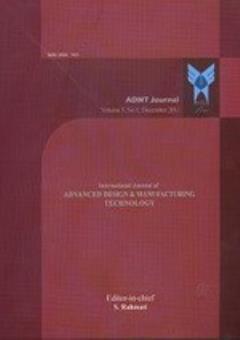A Quasi-Analytical Method Algorithm Development in Redesigning the Geometry and Structural Analysis of An Aircraft Propeller and Comparing with the Finite Element Method
محورهای موضوعی : aerospaceBehrooz Shahriari 1 , Hassan Izanlo 2 , Nedasadat Seddighi 3
1 - Faculty of Mechanics, Malek Ashtar University of Technology, Iran
2 - Faculty of Mechanics, Malek Ashtar University of Technology, Iran.
3 - Mechatronic Sanaat Sepahan Co., Isfahan, Iran
کلید واژه: Aircraft propeller, Stress analysis, Structural analysis algorithm, Quasi-analytical and FE methods, Rotational dynamic stress, Aerodynamic stress,
چکیده مقاله :
The aircraft propeller is effective in the performance of the aircraft propulsion system and must have acceptable structural strength. The complex aerodynamic geometry of the propeller makes its analysis more difficult. In this study, dynamic and aerodynamic stresses are calculated using the Finite Element Method (FEM). A structural analysis algorithm based on the quasi-analytical method is developed to evaluate the finite element analysis. In this regard, first, an algorithm is developed to redesign the propeller which performs in a way that by checking the dimensions, the geometry of the quasi-propeller is determined with the same mass and the coordinates of the center of mass. Then, different algorithms are developed to calculate the distribution of mass, moment of inertia, and the cross-section of the quasi-blade geometry. The calculation algorithms of rotational dynamic and aerodynamic stress distribution are developed. The results show that the FEM and the quasi-analytical method are well matched. In this study, the force equivalent to the thrust and the opposite force to the propeller rotation are placed instead of the aerodynamic pressure distribution. The comparison of the results obtained from the quasi-analytical method and the FEM indicates that the overall maximum stress of the system occurs at the root of the propeller and the maximum net stress due to aerodynamic forces occurs in the middle of the propeller geometry. According to the results, the rotational dynamic stress is much higher than the aerodynamic stress. It is also shown that the aerodynamic stress reduces the overall stress of the system.
The aircraft propeller is effective in the performance of the aircraft propulsion system and must have acceptable structural strength. The complex aerodynamic geometry of the propeller makes its analysis more difficult. In this study, dynamic and aerodynamic stresses are calculated using the Finite Element Method (FEM). A structural analysis algorithm based on the quasi-analytical method is developed to evaluate the finite element analysis. In this regard, first, an algorithm is developed to redesign the propeller which performs in a way that by checking the dimensions, the geometry of the quasi-propeller is determined with the same mass and the coordinates of the center of mass. Then, different algorithms are developed to calculate the distribution of mass, moment of inertia, and the cross-section of the quasi-blade geometry. The calculation algorithms of rotational dynamic and aerodynamic stress distribution are developed. The results show that the FEM and the quasi-analytical method are well matched. In this study, the force equivalent to the thrust and the opposite force to the propeller rotation are placed instead of the aerodynamic pressure distribution. The comparison of the results obtained from the quasi-analytical method and the FEM indicates that the overall maximum stress of the system occurs at the root of the propeller and the maximum net stress due to aerodynamic forces occurs in the middle of the propeller geometry. According to the results, the rotational dynamic stress is much higher than the aerodynamic stress. It is also shown that the aerodynamic stress reduces the overall stress of the system.
[1] Yeh, M. K., Wang, C. H., Stress Analysis of Composite Wind Turbine Blade by Finite Element Method, IOP Conference Series: Materials Science and Engineering, Vol. 241, 2017, pp. 12-15.
[2] Srivastava, S., Roy, A. K., and Kumar, K., Design of a Mixed Flow Pump Impeller Blade and Its Validation Using Stress Analysis, Procedia Materials Science, Vol. 6, 2014, pp. 417-424.
[3] Wu, W. H., Young, W. B., Structural Analysis and Design of The Composite Wind Turbine Blade, Applied Composite Materials, Vol. 19, 2012, pp. 247-257.
[4] Duan, W., Zhao, F., Loading Analysis and Strength Calculation of Wind Turbine Blade Based on Blade Element Momentum Theory and Finite Element Method, Asia-Pacific Power and Energy Engineering Conference, IEEE, 2010, pp. 1-4.
[5] Yeh, M. K., Cheng, Y. C., and Wang, C. H., Finite Element Stress Analysis of Wind Blade Structure Under Wind Pressure, Taiwan Wind Energy Conference, Taipei, Taiwan, No. SI_07, 2015 (in Chinese).
[6] Heo, H., Ju, J., and Kim, D. M., Compliant Cellular Structures: Application to A Passive Morphing Airfoil, Composite Structures, Vol. 106, 2013, pp. 560-569.
[7] Di, T., Zhiliang, L., and Tongqing, G., Aeroelastic Analysis of Large Horizontal Wind Turbine Blades, Applied Mathematics and Mechanics (English Edition), Vol. 37(S1), 2016, pp. S97-S104.
[8] Metallic Material Properties Development and Standardization (MMPDS) Handbook, Battelle Memorial Institute, 2019.
[9] Behzad, M., Izanlo, H., Arghand, H., Davoodabadi, A., and Saleh, A., Bearing Housing Looseness Effect on Rotating Machinery Vibration, 29th International Congress on Sound and Vibration, 2023.


